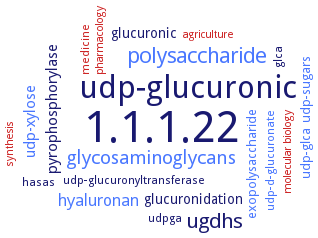Please wait a moment until all data is loaded. This message will disappear when all data is loaded.
Please wait a moment until the data is sorted. This message will disappear when the data is sorted.
Ca2+
84% residual activity at 1 mM
EDTA
83% residual activity at 1 mM
gallic acid
-
is a non-competitive inhibitor with respect to UDP-glucose and NAD+. It decreases specific activities of UGDH, but does not affect UGDH protein expression, thus UGDH activity is inhibited by polyphenols at the post-translational level. Gallic acid exerts strong antiproliferative activity in breast cancer cells. Heat inactivation of UGDH is accelerated to a greater degree by quercetin than by gallic acid. In the presence of gallic acid, the activity remaining after 30 min is 55% that of control
Mn2+
84% residual activity at 1 mM
NaCl
VNG1048G loses much of its activity when salinity drops below 3 M NaCl
NAD+
-
substrate inhibition, reversible by the addition of a nucleotide triphosphate, e.g. ATP, in the absence of kinase. Mutations in a previously identified UDP-glucuronic acid allosteric binding site decrease the binding affinity of the nucleotide triphosphate
phycocyanin
mixed-type inhibitor with respect to both UDP-glucose and NAD+
-
phycocyanobilin
competitive with respect to UDP-glucose and non-competitive with respect to NAD+. Phycocyanobilin is also effective in reducing the colony formation capacity of PC-3 prostate cancer cells and FTC-133 thyroid cancer cells
quercetin
-
shows a competitive inhibition and a mixed-type inhibition with respect to UDP-glucose and NAD+, decreases specific activities of UGDH, but does not affect UGDH protein expression, thus UGDH activity is inhibited by polyphenols at the post-translational level. Quercetin exerts strong antiproliferative activity in breast cancer cells. Heat inactivation of UGDH is accelerated to a greater degree by quercetin than by gallic acid. In the presence of quercetin, the activity remaining after 30 min is 20% that of control
thiol group modifying reagents
-
-
-
UDP
-
0.5 mM, partial inhibition
UDP-alpha-D-xylose
competitive. The DELTA132 deletion mutant and the UDP-alpha-D-xylose-inhibited structures have similar hexamer-building interfaces, suggesting that the hinge-bending motion represents a path for the allosteric transition between the different hexameric states
UDP-galactose
-
0.5 mM, partial inhibition
UDP-glucuronate
Saccharum spp.
-
competitive
UDP-glucuronic acid
product inhibition, 44% residual activity at 1 mM; product inhibition, 79% residual activity at 1 mM
Uridine 5'-diphosphate chloroacetol
-
alkylates a thiol group of cysteine in the catalytic centre via being specifically bound instead of the substrate
NADH

-
0.05 mM, partial inhibition
NADH
-
0.1 mM, presence of 0.1 mM NAD+, 44% inhibition, presence of 0.5 mM NAD+, 6% inhibition
NADH
product inhibition, 26% residual activity at 0.05 mM; product inhibition, 70% residual activity at 0.05 mM
p-chloromercuribenzoate

-
-
p-chloromercuribenzoate
-
0.001 mM, 66% inhibition
piperine

-
stronger inhibition with intestinal cell enzyme than with rat liver enzyme
piperine
-
non-competitive, reversible, non-pH-dependent, 90% inhibition at concentration 0.05 mM and 10% inhibition at concentration 0.01 mM
UDP-alpha-D-glucuronate

-
0.05 mM, partial inhibition
UDP-alpha-D-glucuronate
-
slight product inhibition
UDP-D-xylose

-
-
UDP-D-xylose
-
competitive with UDPglucose
UDP-D-xylose
-
competitive with UDPglucose
UDP-xylose

-
-
UDP-xylose
-
0.05 mM, partial inhibition
UDP-xylose
-
allosteric feedback inhibitor, reduces significantly the activity of the enzyme
UDP-xylose
a potent UGDH inhibitor
UDP-xylose
Saccharum spp.
-
competitive
UDPglucuronate

-
-
UDPglucuronate
-
product feed-back inhibition competitive with UDPglucose
UDPglucuronate
-
product feed-back inhibition competitive with UDPglucose
UDPxylose

-
-
Zn2+

-
the presence of Zn2+ ions markedly stimulates catalytic activity
additional information

-
enzyme is active in the absence of metal ions
-
additional information
-
the enzyme from serotype K30 is not inhibited by NAD+, in contrast to Escherichia coli K-12
-
additional information
-
no substrate inhibition, K+ is not inhibitory up to 500 mM, not inhibitory: dimethyldicarbonate, EDTA
-
additional information
-
in the presence of 0.12 mM 5-azido-UDP-glucose, 89% of the enzyme activity is lost after 5 min of photolabeling. When the enzyme is photolyzed in presence of 1 mM UDP-glucose, 11% of the enzyme activity is lost. 5-azido-UDP-glucose is photoinserting into a UDP-glucose-binding site on the human enzyme in a specific manner. Uracil, uridine, and glucose have a poor protective effect on the labeling, while UDP and UDP-glucose strongly inhibit photoinsertion
-
additional information
-
inhibition of human UDP-glucose dehydrogenase expression using siRNA expression vector in breast cancer cells
-




 results (
results ( results (
results ( top
top






